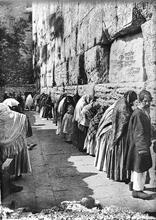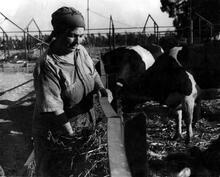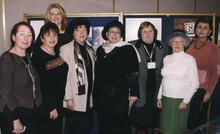Demography: Soviet Union, the Russian Federation and other Successor States
The statistics on Jewish marriage, divorce, fertility, emigration, and aging within the Soviet Union reveal new pockets of history and can shed light on the effects of historical events on Jewish lives. The patterns in demography of different states in the USSR indicate the lifestyles and lifecycles of the Jewish community.
Marriage and Divorce
Before World War II the Jewish marriage pattern was rather favorable for fertility. In 1939 one half of the Jewish women aged 20–24 and more than 70 percent of those aged 25–44 in the Russian Federation were currently married. However, in 1959, the percentage of currently married Jewish females below the age of 25 was much lower than it had been in pre-war 1939 (Table 1). This may be seen as an indirect indicator of the rise in age at first marriage between the two censuses, for which we have no direct data.
| Age group | 1939(a) | 1959(b) | 1970 | 1979 | 1989 |
|---|---|---|---|---|---|
| 16–19 | 5.5(c) | 3.3 | 3.8(c) | 6 | 7.6 |
| 20–24 | 49.6 | 29.3 | 38.8 | 44.5 | 48.9 |
| 25–29 | 70.4 | 67.3 | 70.1 | 70.7 | 72.2 |
| 30–34 | 73.3 | 75.8 | 76.4 | 75 | 75.3 |
| 35–39 | 74.7 | 74.8 | 76.2 | 75.1 | 74 |
(b) Data did not cover some non-Ashkenazic Jews.
(c) 15–19
(d) 60 and over.
| Republics | Mean age at first marriage | Difference | Final celibacy (percentage never-married at ages 45–49) | ||
|---|---|---|---|---|---|
| Males | Females | Males | Females | ||
| Russian Federation | 25.1 | 22.7 | 2.4 | 3.3 | 7.3 |
| Ukraine | 24.9 | 22.2 | 2.7 | 3.2 | 5.3 |
| Belorussia | 25 | 22.5 | 2.5 | 3 | 6.3 |
| Entire USSR | 25 | 22.2 | 2.8 | 3.1 | 6 |
| Age group | Entire USSR | Russian Federation | Ukraine | Belorussia |
|---|---|---|---|---|
| 20–24 | 6.9 | 7 | 7.9 | 6.8 |
| 25–29 | 10.7 | 10.4 | 12.5 | 8.7 |
| 30–34 | 13.3 | 13 | 15.3 | 11.2 |
| 35–39 | 15.9 | 16.1 | 17.2 | 13.7 |
| 40–44 | 18.1 | 18.4 | 19.5 | 15.9 |
Mixed Marriage and Its Consequences
In the postwar period one of the most characteristic features of Soviet Jewry was the great increase in mixed marriage. This increase was the continuation of a process that had already begun between the two world wars (see Table 4). Ethnically mixed marriages were widespread in the Soviet Union, and Jews were no exception among the relatively small and widely dispersed ethnic groups.
| Russian Federation | Ukraine | Belorussia | ||||
|---|---|---|---|---|---|---|
| Year | Males | Females | Males | Females | Males | Females |
| 1924 | 17 | 9 | 4 | 5 | 2 | 3 |
| 1926 | 25 | 17 | 5 | 6 | 2 | 4 |
| 1936 | 44(a) | 35(a) | 18(b) | 16(b) | 13 | 11 |
| 1978 | 59 | 43 | 45 | 34 | 38 | 26 |
| 1988 | 73 | 63 | 54 | 45 | 48 | 40 |
(b) 1939.
In 1988–1989 in the Soviet Union as a whole, among Jews who married, 58 percent of males and 47 percent of females entered into mixed marriages. The share of mixed marriage was highest among divorced Jewish males (62 percent) and lowest among widowed Jewish females (34 percent). Among the Jews of the Soviet Union, those of the Russian Federation had a very high percentage of mixed marriage. The mass migration of the 1990s hastened the erosion of the Jewish marriage market. By 1996, according to the data of annual official vital statistics, the frequency of mixed marriages among all marriages involving Jews in Ukraine had substantially surpassed even that of Russia’s Jews in 1988.
| Republic | 1958 | 1968 | 1978 | 1988 | 1993 |
|---|---|---|---|---|---|
| Former USSR | 19 | ... | ... | 41 | ... |
| Russian Federation | 27 | 40 | 42 | 58 | 68 |
| West | |||||
| Ukraine | 17 | 30 | 31 | 42 | 52 |
| Belorussia | 14 | 32 | 30 | 37 | 71 |
(b) 1987.
(c) 1989.
(d) 1992.
(e) One birth.
(f) Four births to Jewish mothers and non-Jewish fathers.
In the post-war period rising intermarriage in the Soviet Union was accompanied by a great increase in the proportion of children born to mixed couples: from 19 percent in 1958 to about 41 percent in 1988. Corresponding to Russia’s high percentage of mixed marriages, the proportion of these children among all children born to Jewish mothers was greater there than in most other republics (Table 5). Following the start of the recent mass emigration, the proportion of children born to mixed couples among all children born to Jewish mothers continued to grow. By 1998 this proportion had reached 74 percent in the Russian Federation. In 2000 among all children in Latvia born to married Jewish females, 77 percent had fathers from other ethnic groups.
| Republic | Composition of mixed couples | Percentage of children declared Jewish |
|---|---|---|
| Russian Federation | Jewish husband, Russian wife | 6.1 |
| Russian husband, Jewish wife | 4.5 | |
| Ukraine | Jewish husband, Russian wife | 10.3 |
| Russian husband, Jewish wife | 4.9 | |
| Jewish husband, Ukrainian wife | 9.1 |
Fertility
The fertility of Jews in the Soviet Union was for a long time been too low to ensure replacement. In the period preceding the mass emigration that began in the late twentieth century, according to the data of the 1979 and 1989 censuses, various birth cohorts of Russian and Ukrainian Jewish females had very similar levels of fertility. In fact, as of 1919–1923 the birth cohorts of Jewish females in both republics had very stable and low levels of completed fertility—about 1.4–1.5 children or less (Table 7).
| Birth years of women | Age at census date | Average number of children ever born | Percentage of childless women | ||
|---|---|---|---|---|---|
| Russian Federation | Ukraine | Russian Federation | Ukraine | ||
| 1979 census | |||||
| before 1909 | 70+ | 1.59 | 1.71 | 19 | 16.7 |
| 1909–1913 | 65–69 | 1.59 | 1.58 | 17.5 | 16.1 |
| 1914–1918 | 60–64 | 1.56 | 1.54 | 17.4 | 15.3 |
(a) All marital statuses.
The low level of Jewish fertility was only partly caused by a high frequency of permanent infertility. According to the 1979 census, among the women of the oldest cohort (born before 1909) in the Russian Federation 19 percent had had no births, and the percentage of childless women born in 1909–1933 was about 17 percent. In Ukraine frequency of permanent infertility for women born before 1924 was about 15–16 percent. According to the 1989 census, in the younger 1934–1948 cohorts, 14–15 percent of the Jewish women in the Russian Federation never bore children. For Jewish women in Ukraine in these birth cohorts this indicator was lower—10–11 percent.
However, the marriage pattern (age at first marriage and final celibacy; see above) was not the main factor causing low Jewish fertility. The main cause was low marital fertility. According to the 1979 census, the average total number of births in the Russian Federation never exceeded 1.8 children per married Jewish woman born in the first part of the twentieth century, and the fertility of married Jewish women born since 1919 was as low as 1.6 or less. By 1926 the crude birth rate of Jewish mothers in the European part of the Russian Federation had fallen to 19.6 per 1,000 Jews. By 1936, according to partial data, this rate was as low as 15.8 per 1,000 Jews. That is, the Jewish population of the Russian Federation had already reached an advanced stage of fertility reduction before World War II.
In 1988–1989 the total fertility rate (the average number of children that a woman would bear in her lifetime if current age-specific fertility rates remained stable) of Russia’s Jewish population was 1.49. For 1993–1994 this fertility indicator was estimated at about 0.8; that is, it fell dramatically by 46 percent. This coincides with the general negative dynamics of fertility in the total Russian population at this time. In 1988–1989 the total fertility rate of the Jewish population in the Soviet Union as a whole was only slightly higher than in the Russian Federation—1.56. For the Jewish population of the former USSR as a whole this indicator was guesstimated at 0.9 in the mid–1990s, and it would probably not have risen subsequently.
| Year | Russian Federation | Former USSR |
|---|---|---|
| 1958 | 8,937 | 27,904 |
| 1988 | 3,710 | 11,591 |
| 1993 | 1,121 | Less than 3,400 |
| 1998 | 875 | … |
Between 1958 and 1988 the number of children born to Jewish mothers in the Soviet Union fell by 58 percent (Table 8). During this period the reduction in the number of births to Jewish mothers was most pronounced in the Ukraine (by 63 percent), less so in Russia, Belorussia, Latvia and Moldavia (by 56–58 percent), Kazakhstan (by 54 percent), and lowest among the Jews in Uzbekistan (by 35 percent).
Following the onset of mass emigration, from 1988 to 1993, the decline in births in each republic of the former USSR was more intense than during the entire previous three decades. Despite much higher emigration from Ukraine than from the Russian Federation, between 1988 and 1993 the decrease in the number of births to Jewish mothers was slightly more pronounced in Russia (70 percent) than in Ukraine (68 percent). In the Russian Federation most of this decline in the number of births to Jewish mothers has been attributed to the dramatic drop in the level of Jewish fertility, rather than to the mass emigration. Whatever the reason, over the four decades between 1958 to 1998 the total number of children annually born to Jewish mothers fell by 90 percent.
Emigration and Aging
At most adult ages the female’s propensity to migrate is higher than that of the male. This reflects the emigration of Jewish single mothers, and the higher percentage of mixed-married among currently married Jewish males than females. On the other hand, in age group 65–69 the propensity to migrate is lower for females than for males (Figure 1, above). This phenomenon can be explained by the fact that beginning with this age group, the percentage of single Jewish females who never bore children is very high, this being concurrent with the high incidence of female widowhood in the older ages.
Older women without any family members are less liable to emigrate since they are not part of a family. Moreover, according to the 1994 Russian microcensus, 20 percent of the Jewish women aged 65 and above had never given birth. In 1994 the women of this age group constituted 38.2 per cent of the total female population in Russia. If we consider the fact that some of the women who did give birth lost their children, we may then assume that among Jewish women aged 75 and above (who had given birth before World War II) more than one-quarter have no living offspring. This group of childless old Jewish women is quite large, and presents a social problem.
Late twentieth-century mass emigration has hastened the erosion of the Jewish demographic structure. The unusual phenomenon of an increased percentage of never-married may be seen in some Jewish female cohorts. For example, according to the 1994 Russian microcensus, for all the cohorts of women who were between the ages 40–54 at the time of the 1989 census, the percentage of never-married had grown. This may be explained only by the fact that in the period of the recent mass emigration a lower percentage of never-married women emigrated than did women of other marital statuses. The selective character of emigration has also caused a rise in the percentage of Jewish women who never bore children among the cohorts of women who already finished their childbearing. For example, among women aged 55–59 in 1994, 19.0 percent had never given birth, but five years earlier the 1989 census reported that this indicator was only 15.1 percent for these same women, who were then aged 50–54.
One special aspect of the interrelationship between emigration and Jewish fertility in the former USSR should perhaps be noted here. According to Israeli statistics, the level of fertility among ex-Soviet immigrants was somewhat high during their first year in the country: some Jewish women obviously preferred giving birth in Israel, and this may have lowered the level of Jewish fertility in the former USSR. According to some recent data by duration of residence in Israel, the total fertility rate among ex-Soviet immigrants rose to 1.8–2.0; that is, the contemporary level of Jewish fertility in the former USSR (about 0.9; see above) was doubled and approached the level of the total fertility rate of Israeli non-religious Jews.
| Year | Former USSR | Russian Federation | Ukraine | Belorussia |
|---|---|---|---|---|
| 1959(a) | 9 | 9.5 | 9.3 | 6.7 |
| 1970 | 17 | 19.5 | 17.6 | 14.1 |
| 1979 | 25.3 | 28.8 | 27 | 20.5 |
| 1989 | 28.1 | 32.1 | 30.2 | 24.2 |
| ca. 2000(a) (b) | … | 41 | 40.3(c) | 38.3 |
(a) Data did not cover some non-Ashkenazic Jews.
(b) For Belorussia—1999, Ukraine—2001, and the Russian Federation—2002.
(c) According to the data for Kiev city, Dnepropetrovsk, Khar’kov and Odessa Regions, and Crimea including Sevastopol.
Sources: Soviet and Post-Soviet censuses.
From World War II until the start of the mass emigration in the late twentieth the age structure of the Soviet Jewish population substantially worsened, a factor which is linked mainly to the decline in fertility. According to data from the 1989 census of all Jewish women in the Soviet Union, those aged 65 and over constituted 28.1 percent of the total, or 3.1 times more than in 1959 (Table 9). Mass emigration has accelerated this process, and Jewish female population remaining in the former USSR in the early twenty-first century was very old. According to the data from recent post-Soviet censuses, in the Russian Federation and Ukraine more than 40 percent of the women are 65 years old and over.
Altshuler, Mordechai. Soviet Jewry since the Second World War: Population and Social Structure. New York: Praeger, 1987.
Altshuler, Mordechai. Soviet Jewry on the Eve of the Holocaust: A Social and Demographic Profile. Jerusalem: Berghan Books, 1998.
Tolts, Mark. “Jewish Marriages in the USSR: A Demographic Analysis.” East European Jewish Affairs 22, no. 2 (1992): 5–19.
Tolts, Mark. “Jews in Russia: A Century of Demographic Dynamics.” Diaspory/Diasporas (Moscow) 1, no. 1 (1999): 180–198. Available: web.archive.org/web/20020304210354/http://www.archipelag.ru/text/135.htm.
Tolts, Mark. “Jewish Demography of the Former Soviet Union.” In Papers in Jewish Demography 1997, edited by Sergio DellaPergola and Judith Even. Jerusalem (2001): 109–139.
Tolts, Mark. “Demographische Trends unter den Juden der ehemaligen Sowjetunion” (Demographic Trends among the Jews of the Former Soviet Union). Menora: Jahrbuch für deutsch-jüdische Geschichte 2004. Band 15. Berlin/Wien (2005): 15–44.






